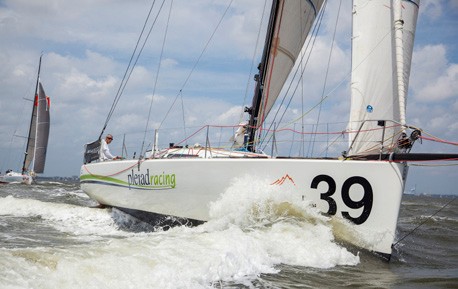Transatlantic Race 2015 starts Sunday, June 28
 Forty-one boats have assembled in Newport, RI for the Transatlantic Race 2015, which has three separate starts on June 28, July 1 and July 5, 2015. The diverse fleet includes a pair of super-maxis, a MOD 70 trimaran and six Class40s – the smallest boats in the fleet – and the legendary Sir Robin Knox-Johnston is skippering an Open 60 named Grey Power.
Forty-one boats have assembled in Newport, RI for the Transatlantic Race 2015, which has three separate starts on June 28, July 1 and July 5, 2015. The diverse fleet includes a pair of super-maxis, a MOD 70 trimaran and six Class40s – the smallest boats in the fleet – and the legendary Sir Robin Knox-Johnston is skippering an Open 60 named Grey Power.
Ed Cesare and Kyle Hubley are sailing Pleiad Racing doublehanded. © Billy Black
Classic entries include Matt Brooks’ 53-foot S&S yawl Dorade, built by Minneford Yacht Yard in City Island, NY in 1930, and the oldest and largest yacht in the race, Charlie Wroe’s 125-foot Mariette of 1915, built by the Herreshoff Manufacturing Co. in Bristol, RI in 1915. A handicapping system affords each yacht, regardless of speed potential, the opportunity to compete for overall honors.
The Transatlantic Race, which charts a 2,796-nautical-mile course from Newport, RI to Lizard Point, South Cornwall, England, is organized by the Royal Yacht Squadron and the New York Yacht Club in association with the Royal Ocean Racing Club and the Storm Trysail Club.
Pre-start activities will take place at the New York Yacht Club’s Harbour Court clubhouse in Newport, while awards will be presented at the Royal Yacht Squadron’s Cowes Castle clubhouse on the Isle of Wight. The finish coincides with the Squadron’s 200th anniversary celebrations.
An epic battle for line honors is in the offing, with George David’s Juan K 88 Rambler 88 (Hartford, CT) taking on Kristy & Jim Clark’s Verdier-VPLP 100 Comanche (Newport, RI), skippered by two-time Volvo Ocean Race skipper Ken Read. Distance races usually recognize two winners: the one who has the fastest corrected time and the one that sails the course in the shortest elapsed time.
Built by Hodgdon Yachts in Boothbay, ME and intended to be the fastest monohull ever built, Comanche was conceived to achieve the latter goal. “Comanche was designed to leverage advanced technology in monohull boat design, and hopefully break some records with the result,” said Clark. “If it’s successful, we hope to hold these records until someone builds a better boat.”
This is not the case for Rambler 88 (built by New England Boatworks in Portsmouth, RI) explained David, who is also serving as a co-chairman of the event. “We’re paying attention to two things: speed through the water and results on handicap,” he said. “The new Rambler has been optimized for IRC [the rating rule utilized by the race] and that’s one reason we like having 12 less feet of waterline length.”
The North Atlantic is one of the toughest stretches of ocean to cross, and with Rambler and Comanche each capable of exceeding 40 knots of boatspeed in the right conditions the crews of both boats are in for a wild ride. Aside from keeping the sailors and boat in one piece, a crew that knows when to push, and how hard, is the key to victory. “The ability to have good group of guys that can let the boat do its thing, unless we’re sailing in conditions where it needs to be held back, is crucial,” said Read. “[Comanche] is an amazing tool, but at the end the day it’s all about people.”
The first boat to reach the Lizard could well be Lloyd Thornburg’s MOD 70 phaedo 3 (GB). Having set a new benchmark for the 1,560 nm passage from Antigua to Newport last month, the bright green speedster’s crew have set their sights on breaking another record.
While the biggest, fastest boats command most of the attention, the most interesting battle may be amongst the smallest boats in the fleet. The six Class40s in the race are competing in the IRC Division and as part of their own sub-class, where they’ll race boat-for-boat across the Atlantic. “Class camaraderie combined with stiff competition is one of the great things about the Class40,” said Ed Cesare of Norwalk, CT, who is co-skippering Pleiad Racing with Kyle Hubley. “Despite the intellectual and physical challenges of the sport – or maybe because of them – things get pretty simple 1,000 miles from land. [Even non sailors] appreciate the passion we have for ocean racing and the fact that we respect the ocean and prepare as well as possible. I tell them ocean racing is risky. I also like to say that the ocean is really forgiving, until it’s not.”
In addition to physical and mental toughness, preparation, teamwork and resourcefulness, expert navigation is essential for success in this race. “An ocean race such as this spreads the fleet out over multiple weather systems,” said David. “Anyone can win.” The Transatlantic Race 2015 is sponsored by Rolex, Newport Shipyard, and Peters & May. For more information, visit transatlanticrace.org.
You can track the fleet at http://www.transatlanticrace.org/2015-06-15-19-18-56/race-tracker
New York Yacht Club Communications Director Stuart Streuli contributed to this report.




